RBSE Solutions for Class 11 Physics Chapter 7 System of Particles and Rotational Motion
Rajasthan Board RBSE Solutions for Class 11 Physics Chapter 7 System of Particles and Rotational Motion Textbook Exercise Questions and Answers.
RBSE Class 11 Physics Solutions Chapter 7 System of Particles and Rotational Motion
RBSE Class 11 Physics System of Particles and Rotational Motion Textbook Questions and Answers
Question 7.1.
Give the location of the centre of mass of a (i) sphere, (ii) cylinder, (iii) ring and (iv) cube, each of uniform mass density. Does the centre of mass of a body necessarily lie inside the body?
Answer:
All the bodies given in the question are symmetrical, therefore their centre of mass will be at their geometrical centre. It is not necessary that the centre of mass of a body lie inside the body. For example, the centre of mass of a ring is at that point where there is no mass.

Question 7.2.
In the HCl molecule, the separation between the nuclei of the two atoms is about 1.27Å (1Å = 10-10 m). Find the approximate location of the centre of mass of the molecule. Given that a chlorine atom is about 35.5 times as massive as a hydrogen atom and nearly all the mass of an atom is concentrated in the nucleus.
Answer:
Suppose the centre of mass of the molecule is situated at a distance x from the H atom.
According to the definition of CM.,
m1r1 = m2r2
∴ mH. x = mcl. (1.27 - x)
or mx = 35.5m (1.27 - x)

or x = 35.5 x 1.27 - 35.5x
or 36.5 x = 35.5 x 1.27
∴ x = \(\frac{35.5 \times 1.27}{36.5}\) = 1.24 Å
or x = 1.24Å
Therefore, the centre of mass will be at 1.24Å from H-atom towards cl atom.
Question 7.3.
A child sits stationary at one end of a long trolley moving uniformly with a speed v on a smooth horizontal floor. If the child gets up and runs about on the trolley in any manner, what is the speed of the centre of mass of the (trolley + child) system?
Answer:
In this action the force applied is internal force. Therefore in absence of external force, there will be no change in speed of the centre of mass i.e., it will remain constant.
Question 7.4.
Show that the area of the triangle contained between the vector \(\vec{a}\) and \(\vec{b}\) is one half of the magnitude of \(\vec{a}\) x \(\vec{b}\).
Answer:
Suppose
\(\vec{AB}\) = \(\vec{a}\)
and \(\vec{AD}\) = \(\vec{b}\)
∆ ABD is obtained between these vectors and parallelogram ABCD is made on base AB.
∵ |\(\vec{a}\) x \(\vec{b}\)| = ab sin θ = (AB) (AD) sin θ
In ∆ AND, sin θ = \(\frac{D N}{A D} \Rightarrow A D=\frac{D N}{\sin \theta}\)
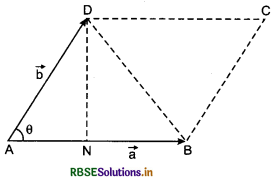
∴ |\(\vec{a}\) x \(\vec{b}\)| = AB x \(\frac{D N}{\sin \theta}\) x sin θ
or |\(\vec{a}\) x \(\vec{b}\)| = AB x DN = Area of parallelogram = 2 x area of ∆ ABD
∴ Area of ABD = \(\frac{1}{2}\)|\(\vec{a}\) x \(\vec{b}\)|
This is to be proved.
Question 7.5.
Show that \(\vec{a}\) |\(\vec{b}\) x \(\vec{c}\)| is equal in magnitude to the volume of the parallel piped formed on the three vectors \(\vec{a}\). \(\vec{b}\) and \(\vec{c}\).
Answer:
Suppose, \(\vec{a}\) = \(\vec{OX}\), \(\vec{b}\) = \(\vec{OY}\) and \(\vec{c}\) = \(\vec{OZ}\)
∴ \(\vec{b}\) x \(\vec{c}\) = b.c.sin 90°.\(\hat{n}\)
= bc.\(\hat{n}\)
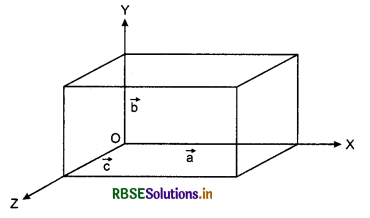
Direction of \(\hat{n}\) will be at right angles to the plane of \(\vec{b}\) and \(\vec{c}\) i.e., in X-direction.
∴ \(\vec{a}\).(\(\vec{b}\) x \(\vec{c}\)) = \(\vec{a}\).bc\(\hat{n}\) = abc.cos 0° = abc
i.e. \(\vec{a}\).(\(\vec{b}\) x \(\vec{c}\)) = Area of parallel piped.

Question 7.6.
Find the components along the X, Y and Z axes of the angular momentum \(\vec{L}\) of a particle, whose position vector is \(\vec{r}\) with components x,y,z and momentum is \(\vec{p}\) with components px, py and pz. Show that if the particle moves only in the X-Y plane, the angular momentum has only Z-component.
Answer:
Here we have
\(\vec{r}\) = x\(\hat{i}\) + y\(\hat{j}\) + z\(\hat{k}\)
and \(\vec{L}\) = Lx\(\hat{i} \) + Ly\(\hat{j}\) + Lz\(\hat{k}\) and \(\vec{p}\) = px\(\hat{i}\) + py\(\hat{j}\) + pz\(\hat{k}\)
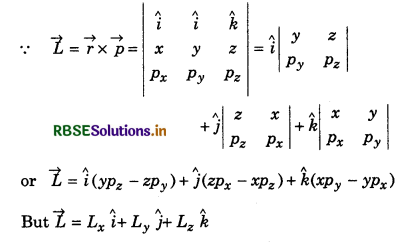
On comparing both the values of \vec{L}, we have
Lx = (ypz - zpy); Ly = (zpx - xpz); Lz = (xpy - ypx)
If the particle moves only in X-Y plane, then Z = 0 and pz = 0
Hence, \(\vec{L}\) = \(\hat{k}\)(xpy - ypx)
It shows that the angular momentum \(\vec{L}\) has only Z-component i.e., Lz = (xpy - ypx)
Question 7.7.
Two particles each of mass ‘m’ and speed 'v' travel in opposite directions along the parallel lines separted by the distance, 'd'. Show that the angular momentum vector of the two particle system is same whatever be the point about which the angular momentum is taken.
Answer:
Suppose the particles are moving along the parallel lines AB and CD situated at a distance d. Let us consider three point, P, O and Q about which we take angular momentum.
Angular momentum of the system about the point P,
\(\overrightarrow{L_P}=\overrightarrow{L_1}+\overrightarrow{L_2}=m \vec{v} \times 0+m \vec{v} \times d=m \vec{v} \cdot d\)
Similarly, that about the point Q,
\(\overrightarrow{L_Q}=m \vec{v} \times d+m \vec{v} \times O=m \vec{v} \cdot d\)
Now, angular momentum of the system about the point O
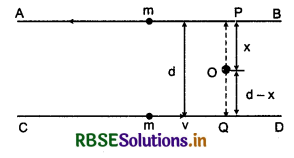

i.e., angular momentum of these two particle systems remains the same whatever be the point about which it is taken.
Question 7.8.
A non-uniform bar of weight W is suspended at rest by two strings of negligible weight as shown in the figure. The angles made by the strings with the vertical are 36.9° and 53.1° respectively. The bar is 2 m long. Calculate the distance d of the centre of gravity of the bar from its left end.
Answer:
Let θ1 = 36.9°; θ2 = 53.1° and tensions in strings are T1 and T2 respectively. On resolving both tensions in horizontal and vertical components, we find:
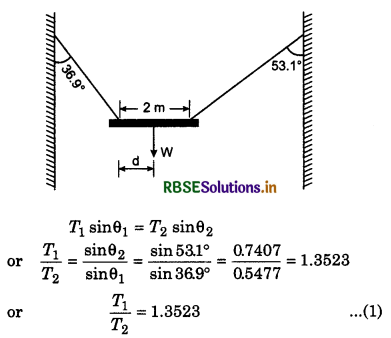
Suppose the centre of mass i.e., the centre of gravity is at a distance d from the left end of the rod, then the rotational equilibrium,
T1 cos θ1 x d = T2 cos θ2 x (2 - d)
or T1 x cos 36.9° x d = T2 x cos 53.1° x (2 - d)
or T1 x 0.8366 x d = T2 x 0.6718 x (2 - d) ...............(2)
From equation (1),
T1 = T2 x 1.3523
On substituting this value in equation (2),
T2 x 1.3523 x 0.8366 x d = T2 x 0.6718 x (2 - d)
or 1.131334 d = 1.3436 - 0.6718 d
or d(1.1313 +0.6718) = 1.3436
ICD = Icm + Mh2
= IAB + MR2
= \(\frac{2}{5}\) MR2 + MR2
or ICD = \(\frac{7}{5}\) MR2
I = \(\frac{3}{2}\) MR2
Question 7.11.
Torques of equal magnitude are applied to a hollow cylinder and a solid sphere, both having the same mass and radius. The cylinder is free to rotate about its standard axis of symmetry and the sphere is free to rotate about an axis passing through its centre. Which of the two will acquire a greater angular speed after a given time?
Answer:
Moment of inertia of the hollow cylinder about its standard axis,
I1 = MR2 and τ = I1α1
∴ α1 = \(\frac{\tau}{I_1}=\frac{\tau}{M R^2}\)
From first equation of rotational motion, the angular velocity attained after a certain time t,
ω1 = ω0 + α1t = α1t
or ω1 = \(\frac{\tau}{M R^2}\).t ......................(1)
Similarly the moment of interia of solid sphere about an axis passing through its centre,
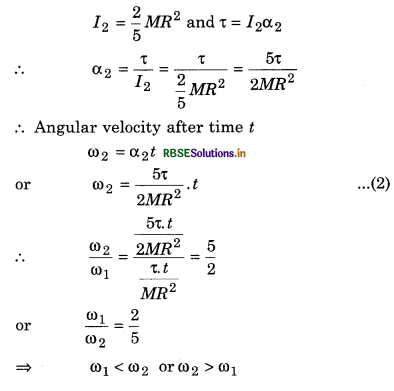
i.e., the angular speed of the sphere will be greater than that of the hollow cylinder.
Question 7.12.
A solid cylinder of mass 20 kg rotates about its axis with angular speed 100 rad s-1. The radius of the cylinder is 0.25 m. What is the kinetic energy associated with the rotation of the cylinder? What is the magnitude of angular momentum of the cylinder about its axis?
Answer:
Moment of interia of soild cylinder about its axis
I = \(\frac{1}{2}\)MR2
where M is its mass and R is its radius
Given: M = 20 kg; R = 0.25 m
∴ I = \(\frac{1}{2}\) x 20 x 0.25 x 0.25 = 10 x 0.0625
or I = 0.625 kg m2
and angular velocity, ω = 100 rad s-1
∴ Rotational kinetic energy of the cylinder
ER = \(\frac{1}{2}\)Iω2 = \(\frac{1}{2}\) x (0.625) x 100 x 100 = 3125 J
or Er = 3125 J
Angular momentum of the cylinder about its axis,
L = Iω = 0.625 x 100
or L = 62.5 kg m2 s-1
Question 7.13.
(a) A child stands at the centre of a turntable with his two arms outstretched. The turntable is set rotating with an angular speed of 40 rev min-1. How much is the angular speed of the child if he folds his hands back and thereby reduces his moment of inerita to 2/5 times the initial value? Assume that the turntable rotates without friction.
(b) Show that the child’s new kinetic energy of rotation is more than the initial kinetic energy of rotation. How do you account for this increase in kinetic energy?
Answer:
(a) Initial moment of inertia of the system
I1 = I
On folding the hand, the moment of inertia of the system,
I2 = \(\frac{2}{5}\)I1
or I2 = \(\frac{2}{5}\)I
ω1 = 40 revolution min-1; ω2 = ?
According to the principle of conversation of angular momentum,
I2ω2 = I1ω1
or \(\frac{2}{5}\) I.ω2 = I x 40
∴ ω2 = \(\frac{5 \times 40}{2}\) = 100 revolution min-1.
(b) Initial kinetic energy of rotation,
K1 = \(\frac{1}{2}\) I1ω12 = \(\frac{1}{2}\) I.ω12
and final kinetic energy of revolution,
K2 = \(\frac{1}{2}\) I2ω12 = \(\frac{1}{2}\) x \(\frac{2}{5}\)I x (\(\frac{2}{5}\)ω1)2 = \(\frac{5}{2}\)(\(\frac{1}{2}\) Iω12)
or K2 = \(\frac{5}{2}\) K1 = 2.5 K1
or K2 = 2.5 K1
i.e., Final kinetic energy of rotation is 2.5 times the initial kientic energy of revolution.
Explanation: The child uses his internal energy to increase his kinetic energy of rotation.
Question 7.14.
A rope of negligible mass is wound round a hollow cylinder of mass 3 kg and radius 40 cm. What is the angular acceleration of the cylinder if the rope is pulled with .a force of 30 N? What is the linear acceleration of the rope? Assume that there is no slipping.
Answer:
Moment of inertia of the hollow cylinder about its geometric axis,
I = MR2
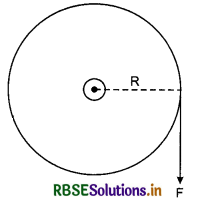
Here, M = 3 kg; R = 40 cm = 0.40 m
∴ I = 3 x (0.4)2 = 0.48 kg m2
When the cord is pulled by a force of 30 N, then applied torque on the cylinder
τ = F.R = 30 x 0.40 = 12 Nm
∴ Angular acceleration
α = \(\frac{\tau}{I}=\frac{12}{0.48}\) = 25 rad s-2
Linear acceleration of the cord
a = Ra = 0.40 x 25
or a = 10 m s-2
Question 7.15.
To maintain a rotor at a uniform angular speed of 200 rad s-1, an engine needs to transmit a torque of 180 Nm. What is the power required by the engine? [Note: Uniform angular velocity in absence of friction implies zero torque. In practice applied torque is needed to counter frictional torque.] Assume that the engine is 100% efficient.
Answer:
Since the engine is 100% efficient. Therefore power of the engine
P = τ.ω = 180 x 200
= 36000 watt
= 36 x 103 watt
= 36 kW

Question 7.16.
From a uniform disc of radius R, a circular hole of radius R/2 is cut out. The centre of the hole is at R/2 from the centre of the original disc. Locate the centre of gravity of the resulting flat body.
Answer:
Suppose the mass of the disc is M.
∴ Distribution of mass of the disc i.e., mass per unit area of disc = \(\frac{M}{\text { Area }}=\frac{M}{\pi R^2}\)
∴ Mass of removed part from the disc
M' = mass distribution x area of removed part = \(\frac{M}{\pi R^2} \times \pi\left(\frac{R}{2}\right)^2\)
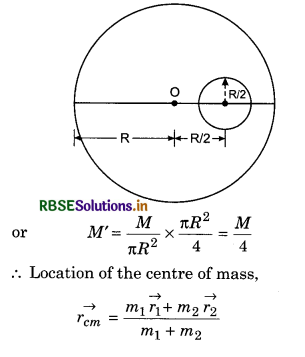
Here m1 = M; r1 = 0
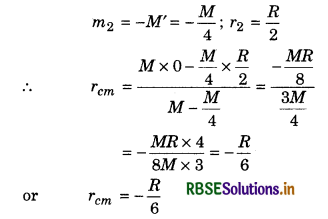
Negative sign indicates here that the location of the new centre of mass will be situated at left side of O.
Question 7.17.
A metre stick is balanced on knife edge at its centre. When two coins, each of mass 5 g are put on the top of other at the 12.0 cm mark, the stick is found to be balanced at 45.0 cm. What is the mass of the metre stick?
Answer:
Suppose the mass of the stick is m. For equilibrium at mark of 45 cm,
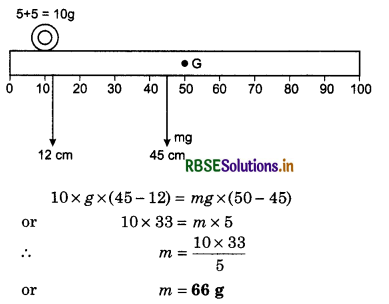
Question 7.18.
A solid sphere rolls down two different inclined planes of the same heights but different angles of inclination, (a) Will it reach the bottom with same speed in each case? (b) Will it take longer to roll down one plane than the other? (c) If so, which one and why?
Answer:
(a) Velocity of a rolling body on the inclined plane at the bottom of the plane,
v = \(\sqrt{\frac{2 g h}{1+\frac{K^2}{R^2}}}\)
where h is the height of the inclined plane for the solid sphere:
I = MK2 = \(\frac{2}{5} M R^2 \Rightarrow \frac{K^2}{R^2}=\frac{2}{5}\)
∴ v = \(\sqrt{\frac{2 g h}{1+\frac{2}{5}}}=\sqrt{\frac{10 g h}{7}}\)
It is clear from this relation that the velocity of rolling down the inclined plane does not depend on the inclination of the plane. Therefore the velocity of sphere at the bottom will be same for both the planes.
(b) Time taken by rolling body on the inclined plane,
t = \(\sqrt{\frac{2 S\left(1+\frac{K^2}{R^2}\right)}{g \sin \theta}}\)
Thus the time taken in rolling down an inclined plane depends on the angle of inclination of the plane. For smaller value of θ,time will be more.
(c) Acceleration on the inclined plane,
a = \(\frac{g \sin \theta}{1+\frac{K^2}{R^2}}\)
i.e., a ∝ sin θ
Therefore for smaller value of θ, ‘a’ will be small and hence time will be more.
Question 7.19.
A hoop (like a ring) of radius 2 m weighs 100 kg. It rolls along a horizontal floor so that its centre of mass has a speed of 20 cms-1. How much work has to be done to stop it?
Answer:
Given: R = 2m, M = 100 kg, v = 20cm s-1 = 0.20 ms-1
From work energy theorem,
Work done to stop the ring = Decay in total kinetic energy
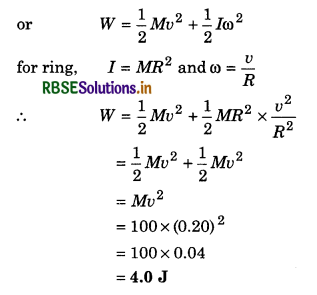
Question 7.20.
The oxygen molecule has a mass of 5.30 x 10-26 kg and a moment of inertia of 1.94 x 10-46 kg m2 about an axis through its centre perpendicular to the lines joining the two atoms. Suppose the mean speed of such molecule in gas is 500 ms-1 and that its kinetic energy of rotation is two thirds of its kinetic energy of translation. Find the average angular velocity of the molecule.
Answer:
Given: Rotational kinetic energy = \(\frac{2}{3}\) x translational kinetic energy
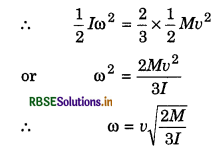
Here, M = 5.30 x 10-26 kg; I = 1.94 x 10-46 kg m2; v = 500 m s-1
∴ Angular velocity of rotation,
ω = 500 x \(\sqrt{\frac{2}{3} \times\left[\frac{5.30 \times 10^{-26}}{1.94 \times 10^{-46}}\right]}\)
or ω = 6.75 x 1012 rad s-1

Question 7.21.
A solid cylinder rolls up an inclined plane of angle of inclination 30°. At the bottom of the inclined plane the centre of mass of the cylinder has speed of 5 m s-1.
(a) How far will the cylinder go up the plane?
(b) How long will it take to return to the bottom?
Answer:
(a) θ = 30°; vcm = 5 ms-1
At highest point
mgh = \(\frac{1}{2}\) mv2cm (1 + \(\frac{K^2}{R^2}\))

For cylinder:
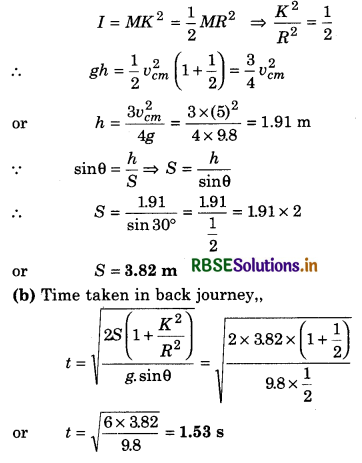
Additional Exercises
Question 7.22.
As shown in the figure, two sides of a step ladder BA and CA are 1.6 m long and hinged at A. A rope DE, 0.5 m is tied half way up. A weight of 40 kg is suspended from a point F, 1.2 m from B along the ladder BA. Assuming the floor to be frictionless and neglecting the weight of the ladder, find the tension in the rope and forces exerted by the floor on the ladder. (Take g = 9.8 ms-2).
[Hint: Consider the equilibrium of each side of the ladder separately.]
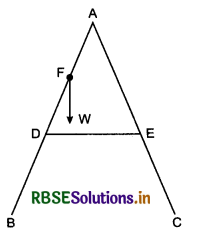
Answer:
For equilibrium of ladder on its both sides, we will have to consider it for both sides separately. Ni and N2 are reaction forces at B and C respectively.
Given: BA = CA = 1.6 m; DE = 0.5 m; m = 40 kg; BF = 1.2 m
∴ DG = 0.25 m
In similar ∆ ABC and ∆ ADE
\(\frac{B C}{D E}=\frac{A B}{A D}\)
or \(\frac{B C}{0.5}=\frac{1.6}{0.8}\) = 2
∴ BC = 0.5 x 2 = 1.0 m
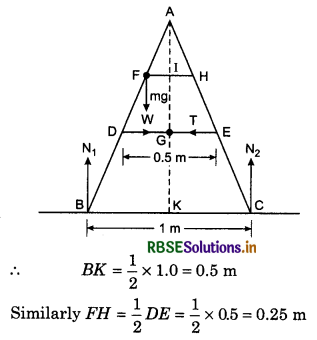
∵ AD = 0.8 m, DG = 0.25 m
∴ AG = \(\sqrt{A D^2-D G^2}=\sqrt{(0.8)^2-(0.25)^2}\)
or AG = 0.76 m
In position of the equilibrium,
N1 + N2 = mg = 40 x 9.8
or N1 + N2 = 392 N ...........................(1)
For rotational equilibrium about A,
-N1 x BK + mg x FI + N2 x CK + T x AG - T x AG = 0
or -N1 x 0.5 x 392 x 0.125 + N2 x 0.5 = 0
[here FI = \(\frac{1}{2}\) FH = \(\frac{1}{2}\) x 0.25 = 0.125 m]
or (N1 - N2) (0.5) = 392 x 0.125
∴ N1 - N2 = \(\frac{392 \times 0.125}{0.5}=\frac{392}{4}\) = 98 N
or N1 - N2 = 98 N ..................................(2)
On adding equations (1) and (2),
2N1 = 490
⇒ N1 = 245 N
∴ N2 = 392 - N1 = 392 - 245
or N2 = 147 N
Taking rotational equilibrium of ladder AB about A,
mg x FI - N1 x BK + T x AG = 0
or 392 x 0.125 - 245 x 0.5 + T x 0.76 = 0
or T x 0.76 = 245 x 0.5 - 392 x 0.125
= 122.5 - 49 = 73.5
∴ T = \(\frac{73.5}{0.76}\)
or T = 76.7 N
Question 7.23.
A man stands on a rotating platform, with his arms stretched horizontally holding a 5 kg weight in each hand. The angular speed of the platform is 30 revolution per minute. The man brings his arms close to his body with the distance of each weight from the axis of rotation changing from 90 cm to 20 cm. The moment of inertia of the man together with the platform may be taken to be constant and equal to 7.6 kgm2.
(a) What is his new angular speed? (Neglect friction)
(b) Is kinetic energy conserved in the process? If not, from where does the change come about?
Answer:
(a) From the principle of conservation of angular momentum,
I1ω1 = I2ω2
∴ω2 = ω1 x \(\frac{I_1}{I_2}\) .......................(1)
Given: I0 = 7.6 kg m2
∴ I1 = I0 + 2mr12 = 7.6 + 2 x 5 x 0.90 x 0.90
= 7.6 + 8.1
or I1 = 15.7 kg m2
ω1 = 30 rev min-1
I2 = I2 + 2mr22 = 7.6 + 2 x 5 x 0.2 x 0.2
7.6 + 0.4
or I2 = 8.0 kg m2
∴ From equation (1)
ω2 = \(\frac{15.7}{8.0}\) x 30 = 58.9 rev min-1
(b) Initial rotational kinetic energy
K1 = \(\frac{1}{2}\)I1ω12 = \(\frac{1}{2}\) x 15.7 x (\(\frac{30}{60}\))2 = 1.96 J
Final rotational kinetic energy
K2 = \(\frac{1}{2}\)I2ω22 = \(\frac{1}{2}\) x 8.0 x (\(\frac{58.9}{60}\))2 = 3.85 J
Thus it is clear that kinetic energy in this process, does not remain cosnerved but increases. Internal energy of the man is converted in this increased kinetic energy.
Question 7.24.
A bullet of mass 10 g and speed 500 ms-1 is fired into a door and gets embedded exactly at the centre of the door. The door is 1.0 m wide and weighs 12 kg. It is hinged at one end and rotates about a vertical axis practically without friction. Find the angular speed of the door just after the bullet embeds into it.
[Hint: The moment of inertia of the door about the vertical axis at one end is \(\frac{M L^2}{3}\)]
Answer:
Moment of interia of the door about the given vertical axis
I0 = \(\frac{1}{3}\)ML2
From law of conversation of angular momentum,
mvr = (I0 + mr2).ω = (\(\frac{1}{3}\)ML2 + mr2).ω
Here: M = 12 kg; m = 10 g = 10 x 10-3 kg = 10-2 kg; v = 500 ms-1; L = 1 m; r = \(\frac{L}{2}=\frac{1}{2}\) m

Question 7.25.
Two discs of moments of inertia I1 and I2 about their respective axes (normal to the disc and passing through the centre), and rotating with angular velocities ω1 and ω2, are brought into contact face to face with their axes of rotation coincident, (a) What is the angular speed of two disc system? (b) Show that the kinetic energy of the combined system is less than the sum of the initial kinetic energies of the two discs. How to account for this loss in energy? Take ω1 ≠ ω2.
Answer:
Suppose both the discs rotate with the angular speed ω after coming in contact.
∵ External torque on the System is zero, therefore the angular momentum of the system will remain conserved.
∴ New rotational kinetic energy of the system,
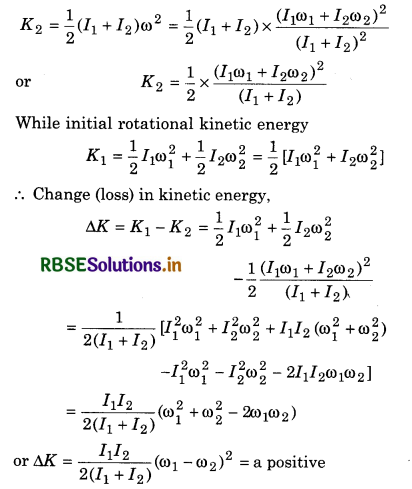
quantity, (because K1 > K2)
Therefore, the loss of energy takes place in one disc system and cause of this loss their is friction between the discs.

Question 7.26.
(a) Prove the theorem of the perpendicular axis.
[Hint: Square of the distance of a point (x,y) in the (x - y) plane from an axis through the origin and perpendicular to the plane is (x2 + y2)]
(b) Prove the theorem of parallel axes.
[Hint. If the centre of mass of the system of n-particles is chosen to be the origin Σmiri = 0]
Answer:
(a) Let perpendicular axes x,y and z (which meet at origin O) so that the body lies in the x-y plane, and the z-axis is perpendicular to the plane of the body. Let Ix, Iy, Iz be moments of inertia about axis x, y, z respectively, the perpendicular axis theorem states that
Iz = Ix + Iy
Proof:
Ix = ∫y2 dm because distance of point (x,y) from x-axis is y
Similarly,
Iy = ∫x2 dm
Iz = ∫(x2 + y2) dm
⇒ Iz = Ix + Iy
(b) Suppose a body of mass m is made to rotate about an axis z passing through the body's center of gravity. The body has a moment of inertia Icm with respect to this axis. The parallel axis theorem states that if the body is made to rotate instead about a new axis z' which is parallel to the first axis and displaced from it by a distance d, then the moment of inertia I with respect to the new axis is related to Icm by:
I = Icm + md2
Proof:
Icm = ∫r2 dm
I = ∫(r ± d)2 dm
= ∫r2 dm + ∫d2 dm ± ∫2 drdm
= Icm + md2
Last term is zero since it gives center of mass.
Question 7.27.
Prove the result that the velocity of translation of a rolling body (like a ring, disc, cylinder or sphere) at the bottom of an inclined plane of a height h is given by v2 = \(\frac{2 g h}{\left(1+\frac{K^2}{R^2}\right)}\), using dynamical consideration (i.e. by consideration of forces and torques). Note K is
the radius of gyration of the body about its symmetry axis and R is the radius of the body. The body starts from rest at the top of the plane.
Answer:
Total energy at the top of the plane = mgh
Total energy at the bottom of the plane = KErot + KEtrans
= \(\frac{1}{2}\) Iω2 + \(\frac{1}{2}\)mv2
I = mk2, v = Rω
Thus mgh = \(\frac{1}{2}\)mk2(\(\frac{v}{R}\))2 + \(\frac{1}{2}\) mv2
⇒ v2 = \(\frac{2 g h}{\left(1+\frac{K^2}{R^2}\right)}\)
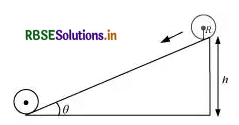
Question 7.28.
A disc rotating about its axis with angular speed ω0, is placed lightly (without any transiâtional push on a perfectly frictionless table). Thee radius of the disc is R. What are the linear velocities of the points AB and C on the disc shown in the figure? Will the disc roll in the direction indicated?
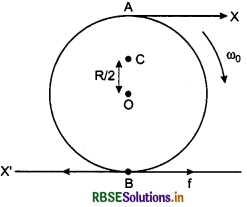
Answer:
Linear velocity v = rω
∴ Velocity at point A, vA = Rω0 (along AX)
Velocity at point B, vB = Rω0 (along BX')
Velocity at point C, vC = \(\frac{R}{2}\)ω (parallel to AX)
Since for rolling motion force of friction is must and here there is no force of friction, therefore disc will not excute rolling motion.
Question 7.29.
Explain why friction is necessary to make the disc in figure of question 7.28 roll in the direction indicated.
(a) Give the direction of frictional force at B, and the sense of frictional torque, before perfect rolling begins.
(b) What is the force of friction after perfect rolling begins?
Answer:
To roll the disc a torque is required, provided by the necessary force of friction as a tangential force.
(a) Frictional force at the point B opposes the velocity of the point B, which is to the left. Consequently, the frictional force has to be to the right in the same direction as the arrow. The sense of frictional torque is such as to oppose the angular motion and acts normal to the plane of the disc and outwards.
(b) Frictional force at the point B decreases the velocity of the point of contact B with the surface. The perfect rolling begins only when the velocity of point B becomes zero and the point of contact B becomes instantaneously at rest. In this situation, the force of friction also becomes zero.
Question 7.30.
A solid disc and ring both of radius 10 cm are placed on a horizontal table simultaneously, with initial angular speed equal to 10π rad s-1. Which of the two will start to roll earlier? The coefficient of kinetic friction is µk = 0.2.
Answer:
Velocity attained by the centre of mass in t s,
v = u + at
∵ u = 0
∴ v = at .......................(1)
Required force of friction for starting the translational motion of centre of mass,
F = ma = µk.mg or a = µk.g
∴ From equation (1),
v = µk g.t ......................(2)
Torque due to friction produces retardation in angular velocity ω0
∴ τ = -Iα = RF = R.µk.mg
or -Iα = µk. mg.R
∴α = \(\frac{-\mu_{k \cdot} \cdot m g \cdot R}{I}\)
∴ From relation,
ω = ω0 + αt
ω = ω0 - \(\left(\frac{\mu_k m g R}{I}\right)\). t .....................(3)
Condition of starting rolling motion,
v = Rω
∴ From equations (2) and (3),
µk gt = R[ω0 - \(\left(\frac{\mu_k m g R}{I}\right)\)t]
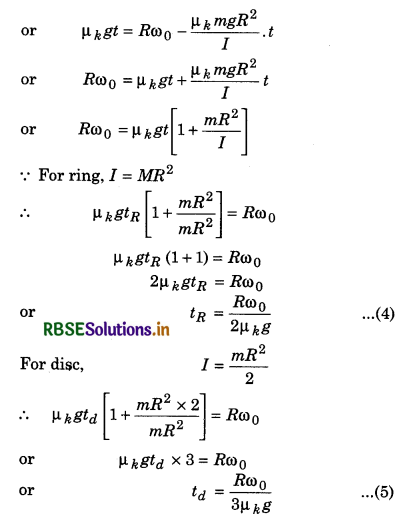
Question 7.31.
A cylinder of mass 10 kg and radius 15 cm is rolling perfectly on a plane of inclination 30°. The coefficient of static friction µs = 0.25.
(a) How much is the force of friction acting on the cylinder?
(b) What is the work done against friction during rolling?
(c) If the inclination θ of the plane is increased, at what value of θ does the cylinder begins to skid and not roll perfectly?
Answer:
Acceleration of the centre of mass in rolling motion on an inclined plane.
a = \(\frac{g \sin \theta}{1+\frac{K^2}{R^2}}\)
For cylinder I = MK2 = \(\frac{1}{2} M R^2 \Rightarrow \frac{K^2}{R^2}=\frac{1}{2}\)
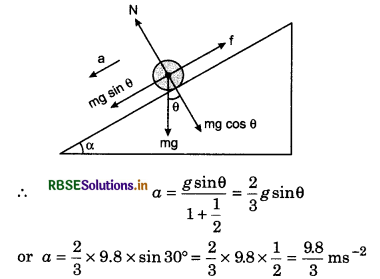
(a) In figure for downward accelerated rolling motion
mg sin θ - f = ma
where f is force of friction on cylinder.
∴ f = mg sin θ - ma
or f = m(g sin θ - a)
= 10[9.8 x sin 30° - \(\frac{9.8}{3}\)]
= 10[\(\frac{9.8}{2}\) - \(\frac{9.8}{3}\)]
= 10 x \(\frac{9.8}{6}\) = \(\frac{9.8}{6}\)
or f = 16.4 N
(b) During rolling motion the point of contact is at rest, therefore work done against friction
W = 0
(c) τ = Iα = \(\frac{I a}{R}\) (because a = αR ⇒ α = \(\frac{a}{R}\))
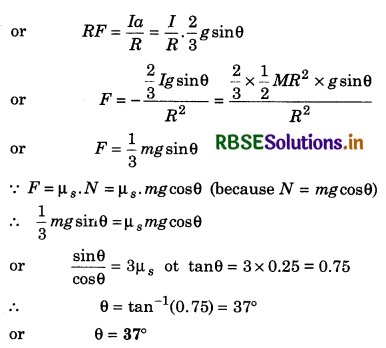

Question 7.32.
Read each statements below carefully, and state, with reasons, if it is true or false:
(a) During rolling, the force of friction acts in the same direction as the direction of motion of CM. of the body.
(b) The instantaneous speed of the point of contact during rolling is zero.
(c) The instantaneous acceleration of the point of contact during rolling is zero.
(d) For perfect rolling motion, work done against friction is zero.
(e) A wheel moving down a perfectly frictionless inclined plane will undergo slipping (not rolling) motion.
Answer:
(a) True: When a body rolls, the force of friction acts in the same direction as the direction of motion of the CM of the body.
(b) True: A rolling can be imagined to be rotating about an axis passing through the point of contact of the body and the ground. Hence the instantaneous speed of the point contact is zero.
(c) False: As the body- is rotating, its instantaneous acceleration can not be zero.
(d) True: Perfect rolling begins when the force of friction is zero. So work done against friction is zero.
(e) True: On a perfectly frictionless inclined plane, there is no tangential force of friction. So the wheel cannot roll. It will simply slip under the effect of its own weight.
Question 7.33.
Separation of Motion of a system of particles into motion into motion of the centre of mass and motion about the centre of mass.
(a) Show p = pi + mtV
Where pi is the momentum of the ith, particle (of mass m1) and pi = m1v'p Note v't is the velocity of the ith particle relative to the centre qf mass.
Also prove using the definition of the centre of mass Σpi = 0
\(b) Show K = K' + \(\frac{1}{2}\)MV2
where K is the total kinetic energy of the system of particles, K' is the total kinetic energy of the system when the particle velocities are taken with respect to the centre of mass and MV2/2 is the kinetic energy of the translation of the system as a whole (i.e., of the centre of mass motion of the system). The result has been used in Sec. 7.14.
\(c) Show L = L' + R x MV
Where L' = Σri x pi is the angular momentum of the system about the centre of mass with Velocities taken relative to the centre of mass. Remember ri = ri - R, rest the notation is the standard notation used in the chapter. Note L' and MR x V can be said to be angular momenta, respectively, about and of the centre of mass of the system of particles.
(d) Show \(\frac{d L^{\prime}}{d t}=\Sigma r_i \times \frac{d p^{\prime}}{d t}\)
further, show that \(\frac{d L^{\prime}}{d t}\) = τ'ext
where t'ext is the sum of all external torques acting on the system about the centre of mass.
[Hint: Use the definition of centre of mass and third law of motion. Assume the internal forces between any two particles act along the line joining the particles.]
Answer:
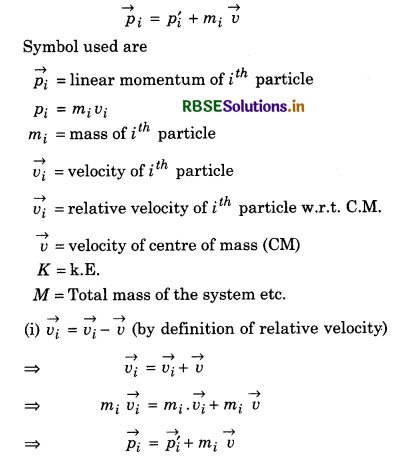
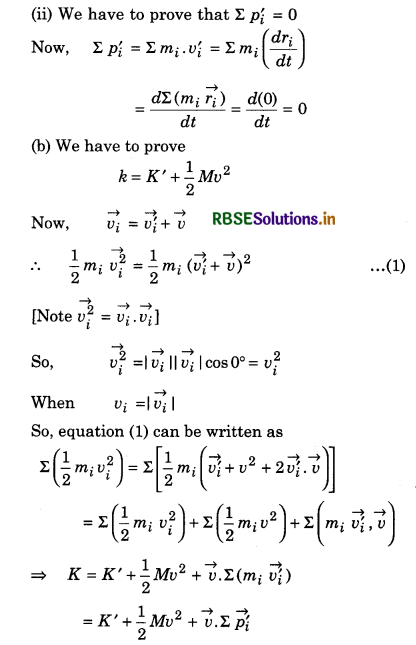
But we have already proved p'i = 0 in the previous part, so
K = K' = \(\frac{1}{2}\)Mv2
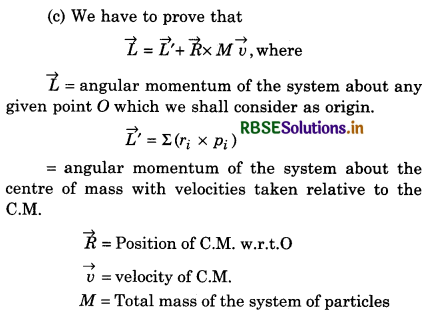
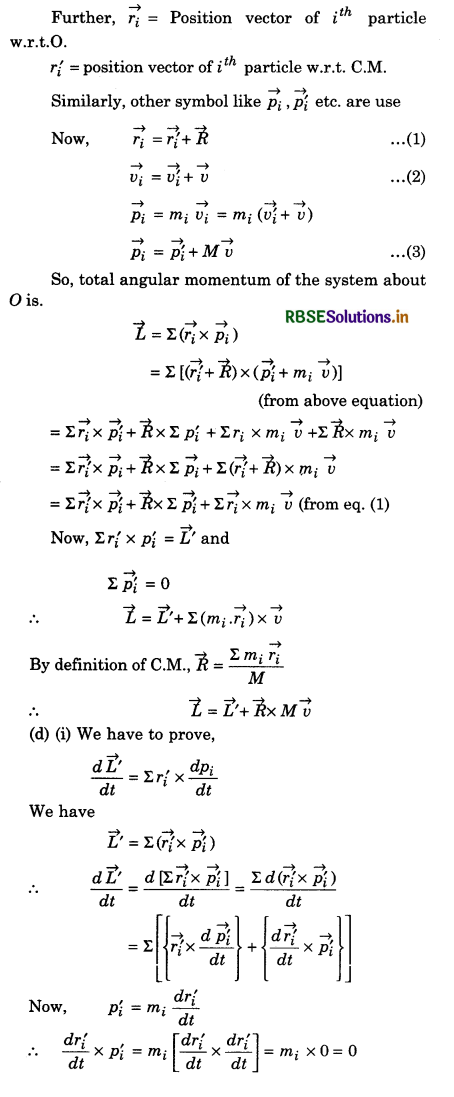
∴ \(\frac{d \vec{L}^{\prime}}{d t}=\Sigma \overrightarrow{r_i^{\prime}} \times \frac{d p_i^{\prime}}{d t}\)
(ii) ∴ \(\frac{d \vec{L}^{\prime}}{d t}=\Sigma \overrightarrow{r_i^{\prime}} \times \frac{d p_i^{\prime}}{d t}\)
Now, from Newton's second law,
\(\frac{d p_i^{\prime}}{d t}\) = External force acting on ith particle = \(\vec{F}_i\)
∴ \(\frac{\overrightarrow{d L^{\prime}}}{d t}=\Sigma \overrightarrow{r_i^{\prime}} \times F_i\)
= Sum of all external torque acting on the system about the centre of mass.
= \(e_{e x t}^{\vec{\prime}}\)
